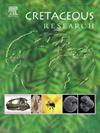南巴塔哥尼亚(阿根廷)的马斯特里赫特气候:从含恐龙的Chorrillo组古土壤的研究
IF 1.7
3区 地球科学
Q1 GEOLOGY
引用次数: 0
摘要
巴塔哥尼亚南部(~ 50°S, Austral-Magallanes盆地,阿根廷)的上马斯垂克岛(Maastrichtian)的Chorrillo组保存了以垂直特征为主的古土壤序列(即阿根廷湖水形态的versols, Perito Moreno冰川钙化的versols, Anita Farm versols, Centinela River Histosols和Chorrillo Malo Farm泥质versols)。为了进一步阐明和提高我们对K/Pg灭绝事件前巴塔哥尼亚南部的气候条件的认识,我们利用大量的Chorrillo组古土壤地球化学资料,定量地重建了南半球中高纬度地区最新的白垩纪气候,并将其与基于古土壤地球化学记录的马斯垂克晚期全球气候数据进行了比较。大量地球化学数据表明,该盆地的成土作用发生在中等化学风化速率下,属于温带-亚热带湿润气候。这些条件与先前的定性解释一致,这些定性解释基于对这些古土壤的宏观和微观形态和矿物学分析,以及对Chorrillo组的孢粉学分析,进一步证明了降雨的季节性。这里提供的气候数据与全球古气候重建一致,我们的研究区域(古54°S)位于马斯特里赫特paleo-Köppen气候带“温带湿润亚热带”,这表明在马斯特里赫特期间,亚热带条件向南美洲的两极延伸了至少22°纬度。这项研究提供了新的、相关的定量古气候学数据,这些数据来自南半球约束较差的中高纬度地区,完善了当前的晚白垩纪气候重建。本文章由计算机程序翻译,如有差异,请以英文原文为准。
Maastrichtian climate of southern Patagonia (Argentina): An approach from paleosols of the dinosaur-bearing Chorrillo Formation
The upper Maastrichtian dinosaur-bearing Chorrillo Formation in southern Patagonia (∼50° S, Austral-Magallanes Basin, Argentina) preserves successions of paleosols dominated by vertic features (i.e., the Argentino Lake hydromorphic Vertisols, the Perito Moreno Glacier calcic Vertisols, the Anita Farm Vertisols, the Centinela River Histosols, and the Chorrillo Malo Farm argillic Vertisols). To shed new light on and improve our understanding of the climate conditions that prevailed in southern Patagonia prior to the K/Pg extinction event, we used bulk geochemistry of the Chorrillo Formation paleosols to quantitatively reconstruct the latest Cretaceous climate at mid–high paleolatitudes of the Southern Hemisphere and compare them with late Maastrichtian global climate data derived from paleosols-based geochemical records. Bulk geochemical data indicate that pedogenesis occurred under moderate chemical weathering rates, which operated in a humid climate with a thermic regime (temperate-subtropical). These conditions align with previous qualitative interpretations based on macro- and micromorphological and mineralogical analyses of these paleosols, as well as palynological analyses of the Chorrillo Formation, which further demonstrate seasonality in rainfall. The climate data presented here are consistent with global paleoclimate reconstructions, where our study area (paleo-54° S) lies within the Maastrichtian paleo-Köppen climate zone “Temperate humid subtropical,” suggesting that during the Maastrichtian, subtropical conditions extended toward the poles by at least 22° of latitude in South America. This research provides new, relevant quantitative paleoclimatological data from the poorly constrained mid–high paleolatitudes of the Southern Hemisphere, refining current latest-Cretaceous climate reconstructions.
求助全文
通过发布文献求助,成功后即可免费获取论文全文。
去求助
来源期刊

Cretaceous Research
地学-地质学
CiteScore
4.10
自引率
19.00%
发文量
235
审稿时长
12 weeks
期刊介绍:
Cretaceous Research provides a forum for the rapid publication of research on all aspects of the Cretaceous Period, including its boundaries with the Jurassic and Palaeogene. Authoritative papers reporting detailed investigations of Cretaceous stratigraphy and palaeontology, studies of regional geology, and reviews of recently published books are complemented by short communications of significant new findings.
Papers submitted to Cretaceous Research should place the research in a broad context, with emphasis placed towards our better understanding of the Cretaceous, that are therefore of interest to the diverse, international readership of the journal. Full length papers that focus solely on a local theme or area will not be accepted for publication; authors of short communications are encouraged to discuss how their findings are of relevance to the Cretaceous on a broad scale.
Research Areas include:
• Regional geology
• Stratigraphy and palaeontology
• Palaeobiology
• Palaeobiogeography
• Palaeoceanography
• Palaeoclimatology
• Evolutionary Palaeoecology
• Geochronology
• Global events.
 求助内容:
求助内容: 应助结果提醒方式:
应助结果提醒方式:


